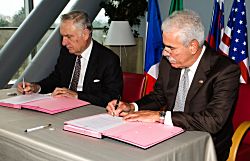HRMC Chairman Joe Faraldo analyzes Lasix debate
April 7, 2019,Columbus, OH – In Sunday’s (April 7) Harness Racing Update, Harness Racing Medication Collaborative Chairman and Standardbred Owners of New York President Joe Faraldo’s Letter to the Editor in the publication’s Feedback section provides an informed analysis of the use of Lasix, the diuretic, race-day medication that is undergoing considerable scrutiny right now.

HRMC Chairman and SOA of NY President Joe Faraldo’s letter to HRU provides an astute analysis of the current debate on Lasix. USTA Photo.
In his letter, Faraldo explains the therapeutic benefits of Lasix in controlling Exercise Induced Pulmonary Hemorrhage as the best protocol for the welfare of the horse, the extremely high incidence of EIPH and the long-term physiological damage it does as well as the myth of the use Lasix as a masking agent for other drugs.
Also, Faraldo discusses the “horrible, horrible loss of (Thoroughbred) life at Santa Anita” and how Lasix is being “inexplicably blamed as the proximate cause of those catastrophes.”
Following is the text of Faraldo’s letter to HRU. To read today’s HRU, click here.
Faraldo: Lasix is not juice, it is a therapeutic medication
Exercise-induced Pulmonary Hemorrhage (EIPH) has been a recognized condition in horses since the early 18 century. While the amount of bleeding in horses varies, it is universally recognized that the vast majority of horses in training and racing do indeed bleed.
The advent of the flexible endoscope confirmed in studies that in thoroughbreds the stress put upon them, proved that up to 75 percent of them bleed in training and more so in racing.
Other studies done on standardbred and thoroughbreds, after running three races, showed that 100 per cent of these horses bled at least once, evidenced by blood in the trachea. The cause of the bleeding is the amount of pressure experienced that racing puts on the pulmonary veins, four times the normal pressure. The pressure causes fibrosis and in turn Pulmonary fibrosis scars and thickens the tissue around and between the air sacs (alveoli) in the lungs, which decreases the lungs ability to function and decreases the racing life of the horse.
I have attended multiple-day seminars with experts from all over the globe on the topic of the race day administration of Lasix. In North America, Lasix is the most popular medication for treating EIPH because studies have shown that it is the most effective treatment in decreasing the amount of bleeding and therefore the scarring and thickening of the tissue around the lungs.
In many of the English speaking countries around the world conducting racing, where race day use of Lasix is prohibited, it is nonetheless permitted up to race day because it is acknowledged to have the desired therapeutic effects in controlling EIPH. One has to ask if it is recognized as necessary in training because of its control of this problem, when the stress is not as severe as when a horse competes in a race, then what is the rationale for withholding it on race day, where four times the normal pressure in the racing environment exists?
It has been said that when our horses, mainly thoroughbreds, go overseas they compete quite well without Lasix. That is indeed true, perhaps because they have a least had the benefit of controlling pulmonary hemorrhage long enough to achieve success over their foreign competitors. Overseas competition is against horses that are using something far less efficacious than Lasix, or worse nothing at all, to address the long term effects occasioned by the increased stress in racing.
Those who want to join the community of Lasix-free racing point to the alleged masking of other substances, but the controlled administration of the substance; the hourly limitation on its use pre-race( 4-4 1/2 hours); the testing for threshold overages of the substance, has put that argument to bed.
Now the newest mantra for the elimination of race-day Lasix, is the horrible, horrible loss of life at Santa Anita Racetrack. The false claim being, that while the rest of North America continues to help the horse racing on Lasix, without nay correlation to catastrophes, Lasix is being inexplicably blamed as the proximate cause of those catastrophes. The problem, is the potential for the elimination of a recognized effective tool in controlling and minimizing, EIPH that helps the horse cope with the effects of stress.
Santa Anita should be shut down immediately until the true causes of these catastrophes can be accurately determined and corrected. The factors point initially to the track’s surface and under-footing, but the more precise answer must be determined by analyzing all of the multiple possible factors, Lasix, being clearly not the culprit.
Without closing down Santa Anita immediately, the industry, thoroughbred and standardbred alike, comes under tremendous pressure from all those looking to eliminate the industry anyway. Santa Anita is providing fuel to a fire that threatens the game, by racing more in the face of its undetermined cause of these catastrophic breakdowns. Allowing continued suffering at Santa Anita is intolerable and unacceptable and should not continue.
Enough is enough and if one is looking to blame Lasix, it is suggested that one look elsewhere. Every industry organization needs to be heard on any and every false narrative out there. No benefit can be achieved by being silent on issues that threaten our existence.
— Joe Faraldo / New York, NY
